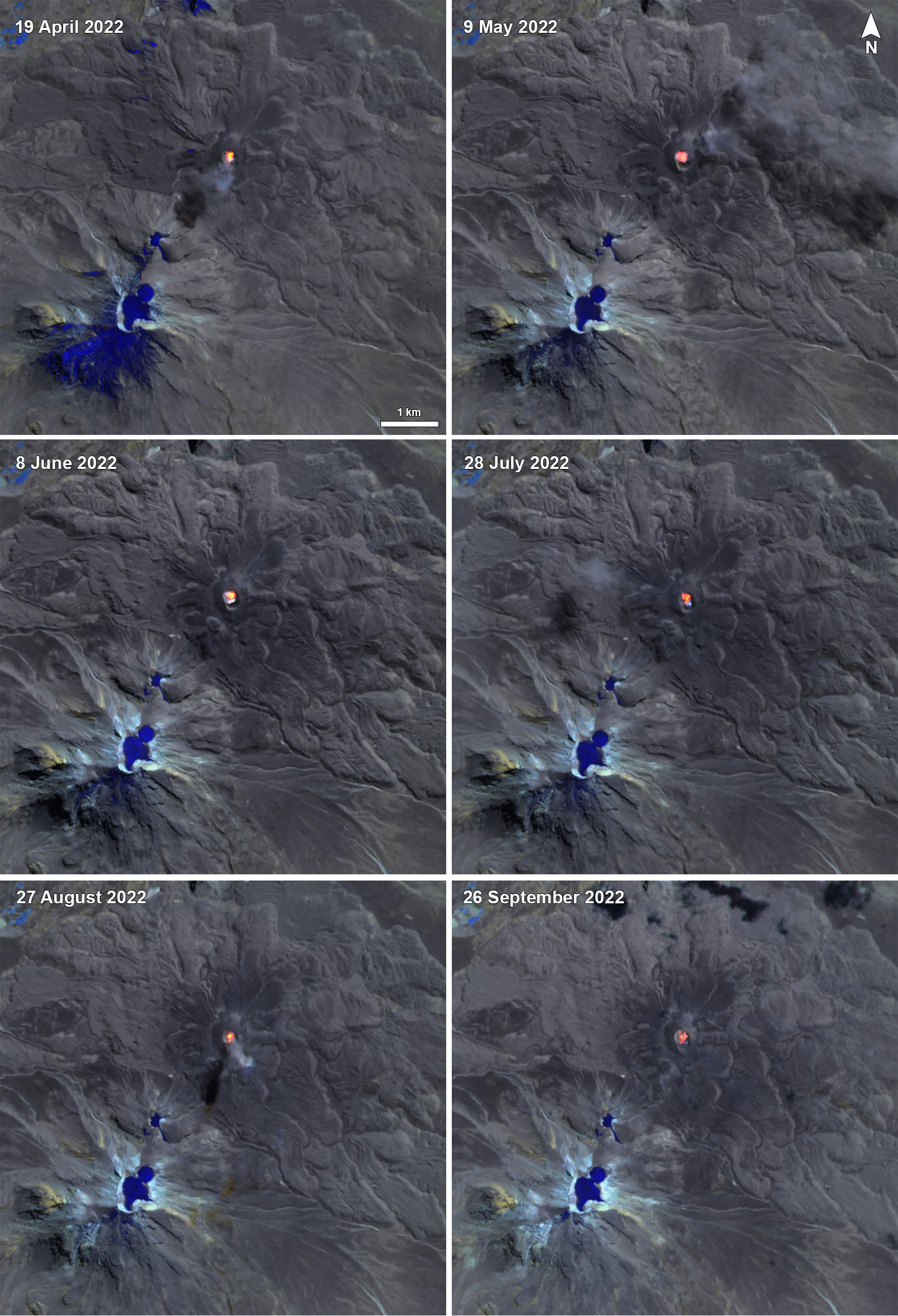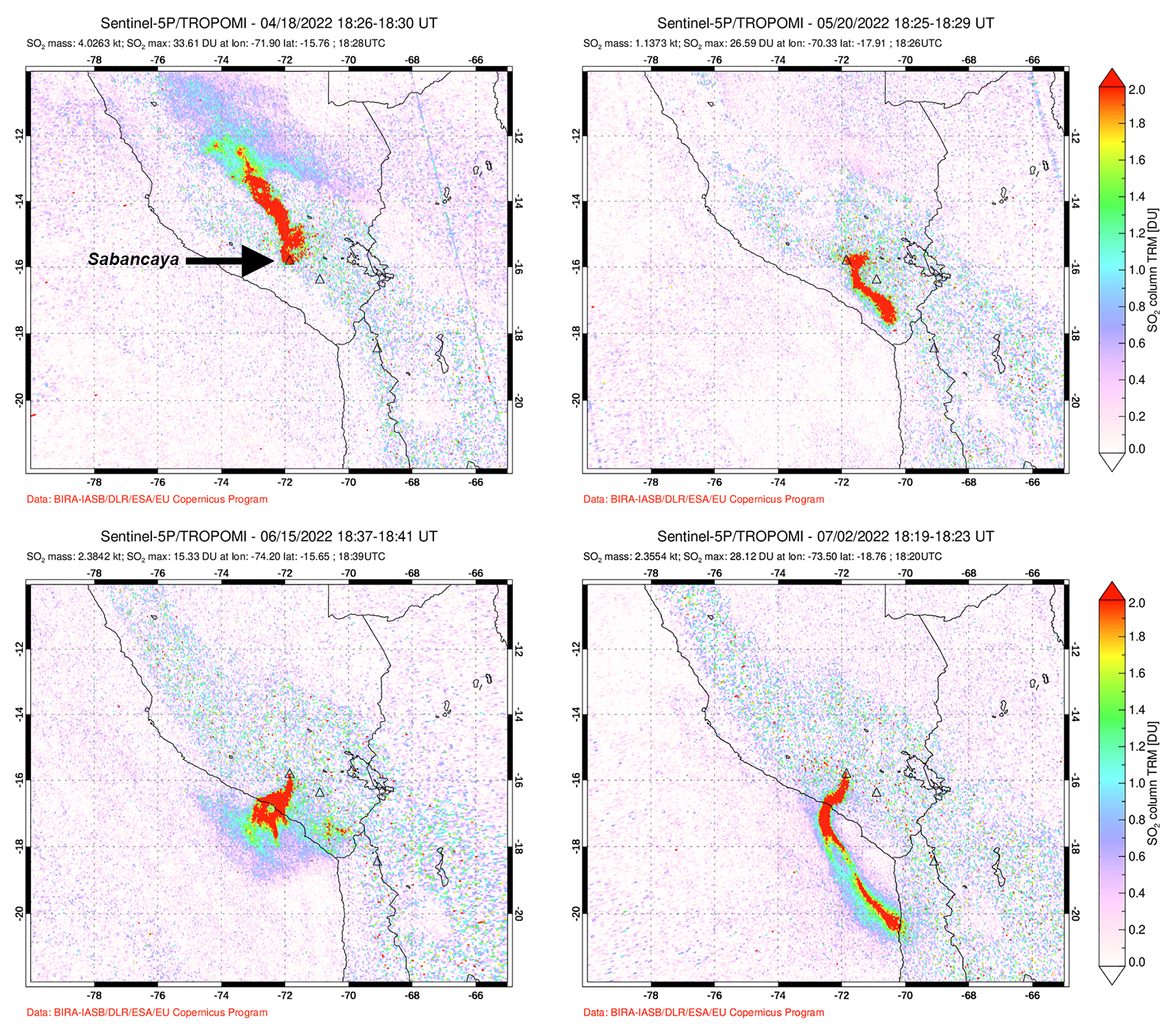Report on Sabancaya (Peru) — November 2022
Bulletin of the Global Volcanism Network, vol. 47, no. 11 (November 2022)
Managing Editor: Edward Venzke.
Edited by Kadie L. Bennis.
Sabancaya (Peru) Daily explosions, gas-and-ash plumes, and thermal activity during April-October 2022
Please cite this report as:
Global Volcanism Program, 2022. Report on Sabancaya (Peru) (Bennis, K.L., and Venzke, E., eds.). Bulletin of the Global Volcanism Network, 47:11. Smithsonian Institution.
Sabancaya
Peru
15.787°S, 71.857°W; summit elev. 5960 m
All times are local (unless otherwise noted)
Sabancaya, located in Peru NE of Ampato and SE of Hualca Hualca, has had Holocene activity that consisted of Plinian eruptions and lava flow effusions, which have formed an extensive apron around the volcano on all sides except the south. Eruptions date back to 1750, with the most recent beginning in November 2016 characterized by frequent, low-energy explosions and gas-and-ash plumes (BGVN 47:05). This report covers activity during April through October 2022 using information from Instituto Geophysico del Peru (IGP) that use weekly activity reports and various satellite data.
Frequent low-to-moderate power thermal anomalies were reported by the MIROVA project during April through October 2022 (figure 116). There was a small gap in detected activity during mid-to-late October. According to data recorded by the MODVOLC thermal algorithm, there was a total of 34 thermal hotspots: 7 in April, 5 in May, 5 in June, 3 in July, 5 in August, 5 in September, and 4 in October. On clear weather days, some of this thermal activity was visible in Sentinel-2 infrared satellite data that showed the active summit crater (figure 117). Moderate-to-strong sulfur dioxide plumes were recorded almost daily during the reporting period by the TROPOMI instrument on the Sentinel-5P satellite (figure 118). Many of these plumes exceeded 2 Dobson Units (DU) and drifted in multiple directions.
IGP reported that moderate levels of eruptive activity continued during April and May 2022; the weekly averages of explosions were 41, 52, 46, 37, and 40 during April, and 53, 54, 21, and 15 during May. Gas-and-ash plumes in April rose 2-3.4 km above the summit and drifted in different directions. During May gas-and-ash plumes rose 2-3 km above the summit and drifted E, SE, N, NE, and S. There were 1,125 volcanic earthquakes recorded during April and 1,337 during May. Seismicity also included volcano-tectonic-type events that indicate rock fracturing events. Thermal activity was frequently reported in the crater due to an active lava dome.
Similar explosive activity continued during June and July. The weekly averages of explosions were 9, 8, 17, and 18 during June, and 22, 20, 28, 30, and 27 during July. Gas-and-ash plumes rose 1.5-2.5 km above the summit and drifted E, SE, and NE during June and rose 1.5-2.7 km above the summit and drifted SE, E, S, N, NW, and SW during July. IGP also detected 945 volcanic earthquakes during June and 1,444 during July; VT-type earthquakes were also reported. Satellite imagery showed persistent thermal anomalies within the crater due to the active lava dome.
The weekly averages of explosions were 19, 25, 33, 48 during August and 58, 44, 47, 50, 46 during September. Accompanying gas-and-ash plumes rose 2.4-2.7 km above the summit and drifted in multiple directions during August and 1.6-3 km above the summit and drifted E, SE, SW, and NE during September. Frequent seismic events continued to be detected; there were 1,378 events reported during August and 1,817 events during September. VT-type events persisted. Satellite data identified several thermal anomalies in the crater due to the active lava dome.
The weekly averages of explosions during October were 45, 56, 40, and 28. The accompanying gas-and-ash plumes rose 2.5-3 km above the summit and drifted W, NE, E, and SE. Seismicity continued, with 1,346 events detected throughout the month, in addition to VT-type events. Thermal activity at the summit crater was commonly detected in satellite imagery.
Geological Summary. Sabancaya, located in the saddle NE of Ampato and SE of Hualca Hualca volcanoes, is the youngest of these volcanic centers and the only one to have erupted in historical time. The oldest of the three, Nevado Hualca Hualca, is of probable late-Pliocene to early Pleistocene age. The name Sabancaya (meaning "tongue of fire" in the Quechua language) first appeared in records in 1595 CE, suggesting activity prior to that date. Holocene activity has consisted of Plinian eruptions followed by emission of voluminous andesitic and dacitic lava flows, which form an extensive apron around the volcano on all sides but the south. Records of observed eruptions date back to 1750 CE.
Information Contacts: Observatorio Volcanologico del INGEMMET (Instituto Geológical Minero y Metalúrgico), Barrio Magisterial Nro. 2 B-16 Umacollo - Yanahuara Arequipa, Peru (URL: http://ovi.ingemmet.gob.pe); Instituto Geofisico del Peru (IGP), Calle Badajoz N° 169 Urb. Mayorazgo IV Etapa, Ate, Lima 15012, Perú (URL: https://www.igp.gob.pe/servicios/centro-vulcanologico-nacional/inicio); Buenos Aires Volcanic Ash Advisory Center (VAAC), Servicio Meteorológico Nacional-Fuerza Aérea Argentina, 25 de mayo 658, Buenos Aires, Argentina (URL: http://www.smn.gov.ar/vaac/buenosaires/inicio.php); MIROVA (Middle InfraRed Observation of Volcanic Activity), a collaborative project between the Universities of Turin and Florence (Italy) supported by the Centre for Volcanic Risk of the Italian Civil Protection Department (URL: http://www.mirovaweb.it/); Hawai'i Institute of Geophysics and Planetology (HIGP) - MODVOLC Thermal Alerts System, School of Ocean and Earth Science and Technology (SOEST), Univ. of Hawai'i, 2525 Correa Road, Honolulu, HI 96822, USA (URL: http://modis.higp.hawaii.edu/); NASA Global Sulfur Dioxide Monitoring Page, Atmospheric Chemistry and Dynamics Laboratory, NASA Goddard Space Flight Center (NASA/GSFC), 8800 Greenbelt Road, Goddard MD 20771, USA (URL: https://so2.gsfc.nasa.gov/); Sentinel Hub Playground (URL: https://www.sentinel-hub.com/explore/sentinel-playground).




